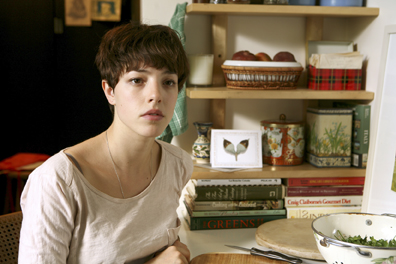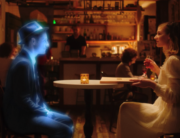
Olivia Thirlby in NOBODY WALKS (Magnolia PIctures)
It seems that It girl Lena Dunham can do no wrong. Her HBO series Girls was recently nominated for a slew of Emmys, including many for actress/writer/director Dunham. It’s a show I’ve become a huge fan of despite that, as a twenty-something girl, the plots tend to hit more than a little close to home. I was excited to find out she co-wrote Nobody Walks with Ry Russo-Young, who also directs. The film, however, while intriguing on many levels, becomes confusing with its themes and intentions, both which work so well on Girls.
Martine (Olivia Thirlby) is a young New York City artist working on an experimental film for an upcoming gallery show. She heads to Los Angeles to seek the help of sound editor Peter (an ever-adorable John Krasinski), whose wife Julie (Rosemarie DeWitt) has a friend in common with Martine. Julie is a psychiatrist and, in what comes off as an unnecessary plot point, has a patient (Justin Kirk) who confesses he has feelings for her. Residing in their pool house, Martine is also exposed to Peter’s handsome assistant, David (Rhys Wakefield), and Julie’s teenage daughter from a previous marriage, Kolt (India Ennenga). Martine’s emergence into this household completely shatters an unconventional yet loving family unit.
The film focuses a lot on her sexuality; she appears to have an effect on every man she comes in contact with. She mostly shrugs it off as something that happens around her. (The guy she makes out with in a deserted airport parking garage turns out to be someone she just met on the plane from NYC; he could easily be mistaken at first for her boyfriend.) Innocent flirtation, which comes naturally to her, becomes more complicated at Peter and Martine’s home. David has a clear attraction to her, but this hurts Kolt, who has a teenaged-obsessed crush on him. Intrigued by Martine’s art, Peter, in turn, develops feelings for Martine as they spend more time together working on her film. This doesn’t go unnoticed by Julie. Aside from Martine, every other character has relationship issues, which makes it impossible for Nobody Walks to successfully resolve, or even address, all of them.
I was a little unsure of how the film wanted to portray Martine. At times it seems she uses her sexuality to her advantage; other times she seems overwhelmed by the situation she finds herself in. Julie is portrayed as a kind of older version of Martine, someone who used to have the same free-spirited artistic life before she settled down with Peter. Kolt, on the other hand, is just starting to come to terms with her own sexuality, as seen in her relationship with a school friend and, more shockingly, in the way her much older Italian language tutor treats her. Despite their differences, the three main female characters make a connection throughout the film that comments on the troubles of desire and being desired. Their stories are what best ties the film together.
Sexually charged throughout, Nobody Walks also focuses on sensory images, especially those Martine uses in her film. Her project concerns insects, and Martine, with the help of Peter, uses sound to make their frantic movements come to life. Martine herself seems to be in a constant state of artsy bliss, wanting to emerge herself in her work instead of getting tangled up in the family. Yet the film has a hard time reconciling these two ideas: Martine’s effect on the family and her artistic endeavor. I wasn’t sure what I was supposed to take away from Martine’s visit except that she leaves behind a lot of damage. Unlike in Girls, where character flaws result in the audience having a better understanding, I left knowing very little about Martine. She is definitely not meant to come off as a villain, but her selfishness doesn’t make her very likable either.






Leave A Comment